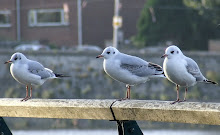ABC Wednesday.... E is for......
Bit of background info. re. the siege: A Royalist army, gathered from Kent, Hertfordshire and Essex occupied colchester. They were supporting King Charles I against Parliament. Once inside the town walls, they were surrounded by the Parliamentarian army, commanded by Lord Fairfax.
The siege lasted through a very cold and wet summer, ending on August 28th 1648. By this time, the residents of the town were so desperate for food that they had begun to eat rats.
(1)The Old Siege House, East Bridge, East Street.


The Old Siege House, taken from the bridge
This Tudor building overlooks a bridge across the River Colne. It was originally part of a mill. The mill was occupied by members of the Parliamentarian army on July 5th 1648. This cut off the bridge, which was used as a route into town by Royalist raiding parties searching for food. It also posed a threat to the south of the town, a place still called The Hythe, which was a port. The Royalists, therefore, decided they could not allow this occupation to take hold.
The building now called The Old Siege House still shows holes from some of the musket balls from these fights:
 [above] Some of the holes made by the musket balls are highlighted with red metal rings around them. I put my hand next to this one to show how big they are.
[above] Some of the holes made by the musket balls are highlighted with red metal rings around them. I put my hand next to this one to show how big they are.
[above] The beams under the "overhang" at the front of the building- more holes left by musket balls.

Spot the holes? This [above] is at the side of the building, facing the river.




This was just one night of the long siege of the town. If you'd like to find out more about the Civil War, here's a link. Or here's a link to a page about the Colchester siege.
(2) The Monument, Castle Park
What happened in Colchester after the siege?
The Royalists surrendered to the Parliamentarians. The townspeople, who had suffered at the hands of both armies, were fined £14,000 (about £2 million in today's terms). Most of the town had been burned. The town walls were ordered to be pulled down, so that nobody would be able to fortify the town ever again. Those remaining Royalist soldiers who were unable to purchase their freedom were herded out of the town, stripped, beaten and left to starve. Many were sent abroad as slaves to the West Indies.
Remember Sir Charles Lucas and Sir George Lisle? The leaders of the fight at East Street? Here is a monument to them, in the grounds of Colchester Castle, where they were later held prisoner, before being executed:
The obelisk marks the spot where they were executed:

I hope you've found this brief look at some of this town's history interesting.
Last, but not least, this wee fella was keeping watch over the monument, so I threw him a nut:
Hard to believe such things took place here, when it was so peaceful walking about with my camera, feeding the squirrels. Perhaps because of the cold and the clear sky, it was so quiet.......
*****
For links to everyone else doing the ABC Wednesday, & instructions on how to take part, visit Mrs Nesbitt's site.
*****

































39 comments:
You live in a very interesting town. The little squirrel at the end of your post is so cute.
That was a neat set of photos and like Dot i too love that last photo. The history is great information
An E-post with a long and interesting story. I have a great interest in history - I have learned quite a lot from your post. Thank you.
An historical E.
I`ve learned something from it also.
I always learn so much on a Wednesday! It is such a day for sitting back and discovering so much. Thanks for this.
An excellently interesting post.
Hi Helena
This is a good choice of E for English war ( the war itself is better to be over!) with ABCwednesday
Greetings,
And please visit my blog for ABC day
JoAnn from Holland
Excellent photos .. and lots of interesting facts!
Wow, these are beautiful. I like old buildings and old things. Great E post.
What an interesting post....and lovely photos, too.
HI ALL!
I AM GOING TO VISIT EVERYONE'S ABC BUT IT MIGHT TAKE A WHILE AS MY JOINTS ARE PLAYING UP BADLY TODAY!!
GLAD YOU LIKED MY POST...
:^)
Fabulous information, I so enjoy learning new STUFF. Super pictures, even the little gray squirrel…he is a cutie
You done a great job on this post. Good shots and a interesting story!
An excellent history lesson. Thank you. And now I need to go create some evidence that I have accomplished something today.
We learn somethings every day,thank you for the tour,very intersting,and a great E-post:o)
Excellent lesson in history! Feel like I am getting a world tour somedays!
Hi Helena,
Interesting post. There is so much history in your part of the world. The old Seige House was shot so many times and yet it still stands!!!
Hi there Helena!
Now that's my type of post!
Great E.
I don't know Colchester, have a friend who once lived there but studied the English Civil War.
I live in the city Charles set up his parliment in, was brought up with-in the war plains & one of my fav. places is Worcester, another besieged city. They have an amazing English Civil War museum.
Best wishes
Blue
PS - you should get the 'Kids' to join in this fun!
That is a very original post for "E". I really enjoyed it. Great pictures too :)
What a fascinating post and an educational tour of your town's history. And a surprise ( a pleasant one, though) to find a squirrel at the end of the tour. You have a fascinating blog and i will certainly be back. Are you planning to sketch the squirrel?
Thanks for all that history. It never occurred to me that you'd still be able to see the musket holes! Don't know why - if the building's still there, the holes would be too!
Interesting post.
Excellent photos to illustrate you very interesting information.
thanks for visiting my blog! I love all your photos and cannot wait to see these kind of buildings when I visit the UK next year! they are gorgeous
What a great history lesson. I'll be sure to visit Colchester WHEN I come back to England! :D
I love history and more so with pictures. It is interesting how they decided to eccentuate the building by showing off the musket ball holes. It's sounds fun to discover the history of your new home town.
Thank you for visiting & commenting on my blog. :)
THANK YOU ALL FOR THE COMMENTS AND FOR STOPPING BY-
I'LL CONTINUE VISITING ALL THE ABC BLOGS TOMORROW: MY HURTING WRISTS MEAN i CAN'T TONIGHT!
LONE GREY SQUIRREL,
I love squirrels and feed them in the park. They take nuts from my hand. They're so gentle when they place one paw on my fingers while they select a nut! I hadn't thought about drawing them, but thanks for the idea.... I might just have a go...!
:^)
The post and the photos are lovely, my favorite being the eastern grey squirrel. Beautiful affectionate photo of the creature. I wish the sentiment in the UK were kinder toward them, I know it has been a struggle. What a kind and intelligent face he has!
www.greyandred.blogspot.com
Now that is some history! Great pictures.
Lovely photos and great information. I learnt a lot about Colchester today :)
Great photos and post. I love a painless history lesson. Thanks.
Very interesting post, I've enjoyed reading the history of Colchester.
Very informative post! Well done!
Hi Helena, I found your post and the pictures fascinating. I studied the English Civil War at school, but this really brings it alive. It is also amazing that after all these years the bullet holes are still in the timbers.
Civil wars are always such a sad part of the history of any nation
Wow, that was a beautiful post, Helena, and the photography is excellent (especially that great shot of the squirrel, you've really captured his cheeky little character!
Very interesting post, I love history. DH has got lots of musket balls, he finds them when he is metal-detecting, I think they are from when people were practising, because you are not allowed on old battlefields.
Hope your joints are better soon.
I was in Clacton on Sea in '05 and we took a trip to Colchester. We went through the castle... did some shopping in a busy district.. I remember there were scads of people... and took some pics of churches...but didn't see this interesting area. Great pics..
love the little squirrel too... very sweet....I mostly have black ones around here. The grey ones are actually a brownish grey....
Musket ball holes... I imagine even more that bounced off the stucco and broke through the windows. Wow.
THANKS EVERYONE for your comments and feedback. It means a lot to me.
Sorry I didn't get to leave messages for you all, or to visit all the other ABC Wednesday blogs... a combination of computer probs and painful joints!! I'll try again this week (slopes off, apologetically....stooping down low...ahem.)
Post a Comment